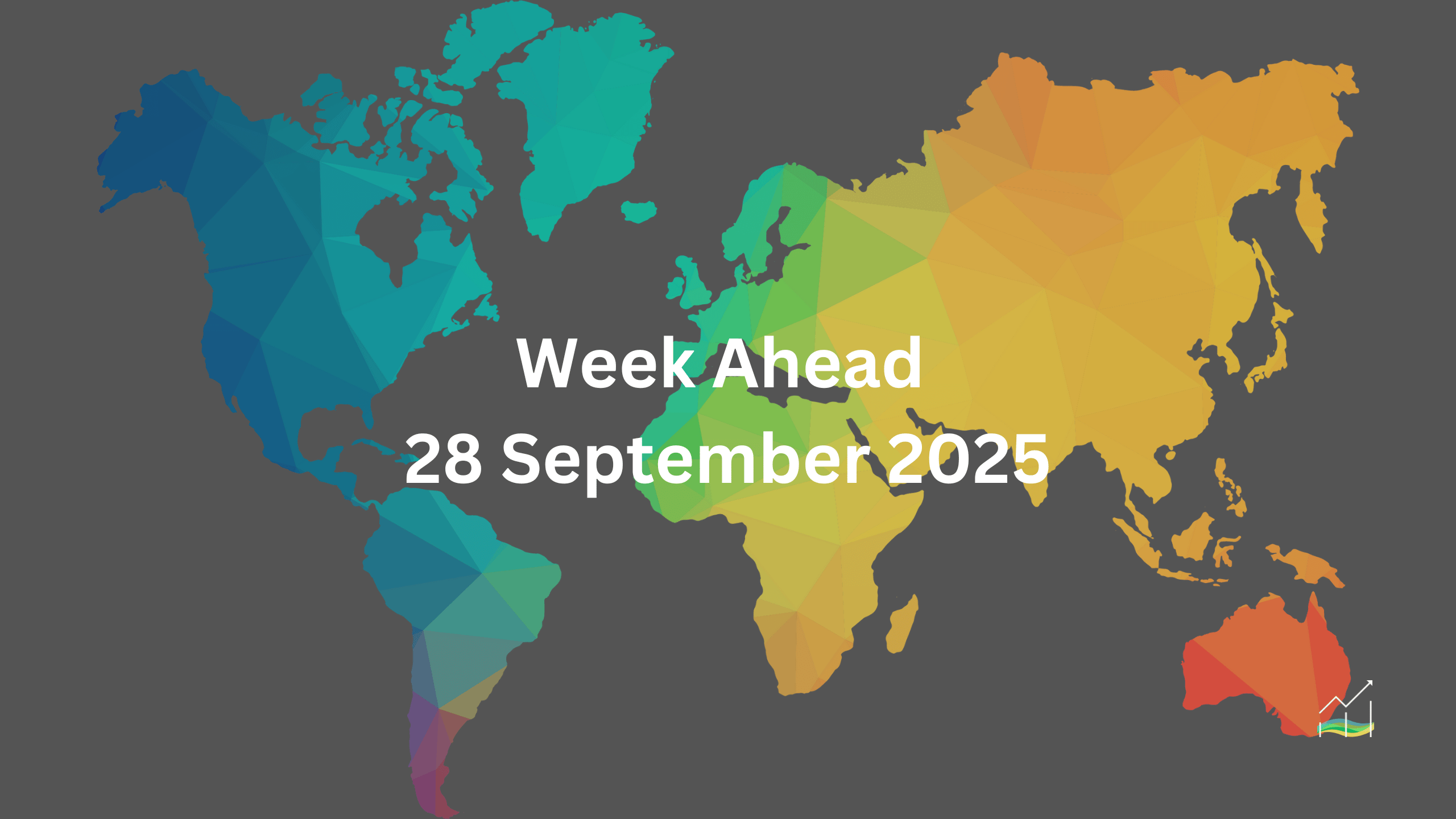28/09/2025 Week Ahead

A Volatile October Ahead
Key Takeaways:
- October opens with elevated geopolitical and economic risks.
- US tariffs expand to new sectors, with major legal challenges ahead.
- Federal Reserve eyes further rate cuts as labor market weakens.
- ECB remains cautious, while Europe faces heightened military tensions.
- China’s political meeting signals new economic planning and potential leadership shifts.
- Foreign demand for US assets stays strong despite volatility risks.
October brings a convergence of major economic and geopolitical forces that could set the tone for the remainder of 2025. Trade tensions, central bank decisions, and rising military risks in Eastern Europe all underscore the fragile global outlook. At the same time, political brinkmanship in Washington raises the threat of a government shutdown, with direct implications for growth and financial stability.
In the United States, tariffs are again in focus. The administration announced sweeping measures from 100% duties on certain pharmaceuticals to levies on trucks, furniture, and steel. Exemptions and enforcement gaps mean the real impact is more nuanced, but ongoing investigations into robotics, medical devices, and machinery suggest broader protectionist policies are still unfolding. A looming Supreme Court case may determine the scope of executive power in tariff implementation, with potential consequences for global supply chains and corporate costs.
Monetary policy adds another layer of uncertainty. The Federal Reserve meets at the end of October with pressure to respond to a weakening labor market. Job growth has slowed sharply, unemployment is rising, and hours worked are declining. Although inflation remains above target, policymakers view employment risks as the greater threat. Markets are pricing in further cuts, but internal Fed divisions highlight the uncertain path ahead.
Across the Atlantic, the European Central Bank is more cautious. Eurozone inflation has eased, and growth remains weak, but officials are hesitant to lower rates further amid defense spending pressures and financial stability concerns. At the same time, military tensions in Poland, Romania, and Estonia underscore the risk of escalation in the Russia-Ukraine conflict, raising concerns of broader NATO involvement.
In China, the Fourth Plenary Session of the Communist Party’s Central Committee will shape the country’s five-year plan from 2026 to 2030. The focus is expected to fall on technological self-sufficiency, energy security, and industrial upgrading. Yet internal political maneuvering, economic headwinds, and speculation about future leadership add uncertainty. The session will be closely watched for signs of both stability and strategic recalibration.
Global markets remain in a fragile balance. Foreign investors continue to buy US assets in large volumes, but geopolitical risk is building on multiple fronts. The intersection of tariffs, rate policy, and rising military tensions makes October a potential inflection point. What happens in Washington, Frankfurt, and Beijing will ripple across economies and markets worldwide.
United States of America
Overview
The United States faces the imminent risk of a federal government shutdown beginning October 1 due to the lack of spending authorization. Both parties appear willing to accept the political and economic costs, believing they have more to gain or less to lose from a temporary closure. Such an event would disrupt the release of economic reports, including the closely watched September employment data due on October 3. Historically, a shutdown trims around 0.1% off GDP for each week it lasts, adding to the uncertainty surrounding growth momentum.
The divergence in GDP estimates highlights the current economic debate. The Atlanta Fed’s tracker points to 3.7% annualized growth in Q3, while Bloomberg’s median survey sits much lower at 1.7%. This discrepancy reflects a mix of resilient spending in some areas and growing signs of labor market weakness. The Federal Reserve has signaled concern over rising unemployment, choosing to prioritize labor stability over short-term inflation risks, which it views as being temporarily lifted by tariffs.
The Fed’s updated Summary of Economic Projections indicates expectations for two further rate cuts this year and three next year. However, the dispersion of views among policymakers remains wide, signaling uncertainty within the committee. Comments from officials suggest the possibility of a dissent in favor of a 50 bp cut at the October 28-29 meeting. Meanwhile, US-China trade relations remain fragile. The upcoming Trump-Xi meeting at the APEC summit is expected to produce another 90-day extension of the current tariff truce, keeping trade risks on hold but unresolved.
Economic Drivers
- Risk of government shutdown from October 1, disrupting economic data releases and weighing on growth.
- Each week of shutdown estimated to shave 0.1% off GDP.
- Wide gap in Q3 GDP forecasts: Atlanta Fed at 3.7% vs Bloomberg median at 1.7%.
- Federal Reserve prioritizing labor market stability over inflation concerns, with updated projections for multiple rate cuts.
- Ongoing US-China tensions with tariff truce likely to be extended another 90 days at APEC.
Data and Events
- 29 September 2025: Pending Home Sales
- 29 September 2025: FOMC Members Speak
- 30 September 2025: JOLTS Job Openings
- 30 September 2025: CB Consumer Confidence
- 01 October 2025: ADP Non-Farm Employment Change
- 01 October 2025: ISM Manufacturing PMI & Price
- 02 October 2025: Unemployment Claims
- 03 October 2025: Average Hourly Earnings
- 03 October 2025: Non-Farm Employment Change
- 03 October 2025: Unemployment Rate
- 03 October 2025: ISM Services PMI
Price Action
No significant price action.
Key Points:
- High risk of federal shutdown from October 1, with economic data disruptions likely.
- GDP impact estimated at 0.1% per week of closure.
- Fed projects two more rate cuts this year, three next year, but policymakers remain divided.
- Trump-Xi meeting at APEC expected to extend tariff truce by 90 days.
- Growth outlook uncertain with labor market weakening and GDP estimates sharply divided.
Australia
Overview
The Australian dollar recently climbed to its highest level this year, briefly touching $0.6710 before easing lower. The move was fueled by what markets perceived as a dovish Federal Reserve statement, but momentum has since faded. Current positioning suggests the currency could move into a corrective phase toward $0.6480-$0.6500 in the near term.
Domestically, Reserve Bank Governor Michele Bullock has pushed back against market expectations of aggressive easing, tempering enthusiasm for additional cuts. Futures pricing indicates that investors still anticipate one more reduction in rates by year-end, with implied levels near 3.35%, the highest since March. Whether this materializes will depend on upcoming labor and consumption data, which remain critical for the policy outlook.
On the geopolitical front, Australia joined Canada and several European countries in formally recognizing Palestine. This move highlights shifting diplomatic priorities and comes as Washington warned such recognition could complicate trade talks with Canada. Additionally, concerns linger around the long-term stability of the AUKUS submarine agreement during President Trump’s second term, underscoring the uncertain strategic landscape. Despite these risks, the medium-term outlook for the Australian dollar remains constructive, with expectations of appreciation toward the $0.7000-$0.7200 range.
Economic Drivers
- Reserve Bank Governor Bullock dampened expectations for further aggressive easing.
- Futures market implies year-end rate around 3.35%, suggesting one more cut in December.
- Labor market and consumption data remain key to monetary policy direction.
- Australia formally recognized Palestine, aligning with Canada and parts of Europe, raising diplomatic and trade implications.
- Strategic concerns persist over the AUKUS submarine deal under current US administration.
Data and Events
- 30 September 2025: Cash Rate
- 30 September 2025: RBA Rate Statement
- 30 September 2025: RBA Press Conference
- 02 October 2025: Goods Trade Balance
- 02 September 2025: Household Spending
- 02 September 2025: RBA Financial Stability Review
Price Action
- AUD/USD peaked near $0.6710, with potential corrective move toward $0.6480-$0.6500.
- Futures pricing signals expectations for one more rate cut, anchoring near-term sentiment.
- Medium-term outlook targets appreciation toward $0.7000-$0.720.
Key Points:
- AUD hit a yearly high but risks correction in the short term.
- RBA maintains a cautious stance, with futures pricing one more cut by year-end.
- Labor and consumption data critical for rate outlook.
- Australia’s recognition of Palestine may affect diplomatic and trade dynamics.
- Medium-term projection favors AUD strength toward $0.7000-$0.7200.
Canada
Overview
The Canadian dollar has been under pressure as the US dollar breaks higher at the end of September, testing levels near CAD1.40 for the first time since April. For most of the past two months, the pair has traded in a narrow CAD1.3820-CAD1.3925 range, but recent momentum suggests the greenback is regaining strength. The Canadian dollar remains closely tied to the broader trend of the US dollar, benefiting during periods of dollar weakness, as seen in July when it was the strongest performer among G10 currencies.
Economic conditions have been less supportive in recent months. Canada’s economy contracted at a 1.6% annualized pace in Q2, weighed down by disrupted trade flows with the United States despite the protection afforded by the USMCA. A softer labor market further prompted the Bank of Canada to extend its easing cycle with a quarter-point rate cut in September, lowering the policy rate to 2.50%. Derivative markets suggest this move went beyond what was previously priced in, underscoring the bank’s concern over weakening demand.
While there are indications the economy may have stabilized in Q3, real consumer spending has slowed considerably, raising questions about the strength of domestic demand heading into year-end. Markets now see the risk that the terminal policy rate may fall below the currently implied 2.25%, adding to the uncertainty surrounding the policy outlook.
Economic Drivers
- Canadian dollar closely tied to shifts in US dollar strength.
- Canadian economy contracted at 1.6% annualized in Q2, driven by disrupted trade with the US.
- Labor market weakening, pressuring economic activity.
- Bank of Canada extended easing cycle with a 25 bp cut in September, lowering policy rate to 2.50%.
- Risk that the terminal rate could fall below the 2.25% implied by current market pricing.
- Consumer spending slowing sharply despite possible Q3 stabilization.
Data and Events
- 01 October 2025: Manufacturing PMI
- 02 October 2025: BOC Summary of Deliberations
Price Action
- USD/CAD traded within CAD1.3820-CAD1.3925 for two months before breaking higher.
- Current momentum suggests potential test of CAD1.40, last closed above in April.
- CAD performance remains sensitive to broad US dollar direction.
Key Points:
- USD/CAD breaking higher after months of range-bound trade, with CAD1.40 in view.
- Canadian economy contracted 1.6% in Q2 due to weaker trade and labor market conditions.
- Bank of Canada cut rates to 2.50% in September, extending easing cycle.
- Consumer spending slowdown raises downside risks for growth.
- Markets see risk of terminal rate falling below 2.25%.
China
Overview
The Chinese yuan held relatively steady through September, slipping less than 0.10% for the month and maintaining a year-to-date gain of about 3.1%. Unlike the previous US administration, which briefly labeled China a currency manipulator, current Treasury Secretary Bessent has taken a more conciliatory stance, welcoming the yuan’s appreciation and framing it as a larger issue for Europe than for the United States. Meanwhile, the People’s Bank of China reaffirmed its intention to maintain broad stability in the currency, signaling no change in its foreign exchange policy.
Domestic political developments will shape October’s outlook. Mainland markets will remain closed during the first week of the month for the national holiday. Later in October, the Fourth Plenary Session of the 20th Central Committee will be held, where the groundwork for the next five-year plan is expected. There is also speculation that President Xi Jinping could use the session to hint at a potential successor, a move that would carry significant political implications. Toward the end of the month, Xi is set to meet President Trump on the sidelines of the APEC summit in South Korea. The absence of a formal bilateral summit highlights how far apart the two sides remain on key issues.
On the geopolitical front, the US recently declined senior Taiwanese visits and rejected a $400 million arms order from Taipei. These moves suggest Washington is attempting to ease tensions with Beijing. Meanwhile, China’s domestic anti-involution campaign continues, though it has delivered limited results so far and is likely to persist.
Economic Drivers
- Yuan gained about 3.1% year-to-date, with only minor losses in September.
- Treasury Secretary Bessent welcomed yuan appreciation, noting greater impact on Europe than the US.
- People’s Bank of China reaffirmed no changes to FX policy, aiming for broad stability.
- Fourth Plenary Session later in October expected to draft next five-year plan, with speculation Xi may signal a successor.
- Xi and Trump set to meet at APEC in South Korea, though not in a formal summit, reflecting unresolved differences.
- US declined senior Taiwanese visits and rejected $400 mln arms order, signaling a shift in tone toward Beijing.
- China’s anti-involution campaign continues despite limited progress.
Data and Events
- 30 September 2025: Manufacturing & Non-Manufacturing PMI
- 30 September 2025: RatingDog Manufacturing & Services PMI
Price Action
No significant price action.
Key Points:
- Yuan gained 3.1% year-to-date, showing stability under PBOC guidance.
- US softened stance, with Treasury welcoming yuan strength.
- Fourth Plenary Session expected to shape next five-year plan, with possible leadership signals.
- Xi-Trump meeting at APEC underscores unresolved tensions despite dialogue.
- Anti-involution campaign continues with limited effectiveness.
Europe
Overview
The euro recently climbed to a four-year high near $1.1920 before entering a consolidation phase. This strength is less about domestic eurozone or EU-specific developments and more about broader US dynamics, particularly expectations for lower US interest rates. The swaps market suggests the European Central Bank is finished with its easing cycle, while the Federal Reserve is anticipated to cut by 100-125 basis points by the end of next year. This divergence in policy outlook has been a central driver of euro appreciation.
Within Europe, sovereign debt markets have remained stable despite credit rating actions. France’s premium over Germany remains relatively wide near 80 basis points following a downgrade, but markets view this as manageable with no systemic concerns. In contrast, Spain, Portugal, and Italy recently received rating upgrades, yet these moves generated little reaction. Overall, markets appear unshaken by credit developments within the bloc.
Two main risks loom over the eurozone. The first is geopolitical, with Russia escalating its war in Ukraine and violating eastern European airspace, prompting the UK and France to reinforce NATO’s eastern flank. The second stems from US tariff actions that could weigh on Europe’s already sluggish growth momentum. Despite these challenges, the underlying trend for the euro remains upward, with expectations of renewed gains after the current consolidation.
Economic Drivers
- Euro strength driven primarily by US rate expectations rather than eurozone-specific developments.
- Swaps market signals ECB has likely ended its easing cycle.
- Federal Reserve expected to cut rates by 100-125 bp by end of next year, supporting euro appreciation.
- France’s 10-year premium over Germany widened to about 80 bp after downgrade, but no systemic stress evident.
- Spain, Portugal, and Italy received rating upgrades with limited market response.
- Escalation of the Russia-Ukraine war and airspace violations raise security risks.
- New US tariffs pose a potential drag on Europe’s fragile economic recovery.
Data and Events
- 29 September 2025: Spanish Flash CPI
- 30 September 2025: German Retail Sales
- 30 September 2025: German Prelim CPI
- 30 September 2025: German Unemployment Change
- 30 September 2025: ECB President Lagarde Speaks
- 01 October 2025: Final Manufacturing PMI
- 01 October 2025: CPI Flash Estimate
- 02 October 2025: Unemployment Rate
- 03 October 2025: Final Services PMI
- 03 October 2025: PPI
- 03 October 2025: ECB President Lagarde Speaks
Price Action
- Euro hit $1.1920, its highest in four years, before consolidating.
- Broader uptrend expected to resume after consolidation.
- Euro strength remains closely tied to US interest rate outlook.
Key Points:
- Euro reached a four-year high before consolidating.
- ECB seen as finished easing, while Fed expected to cut by 100-125 bp next year.
- European bond markets stable despite France downgrade and southern Europe upgrades.
- Risks from Russia-Ukraine conflict and US tariffs weigh on sentiment.
- Euro’s uptrend likely to resume after consolidation phase.
Japan
Overview
The yen has traded in a narrow band since early July, mostly between JPY146 and JPY150 per dollar, with the exchange rate largely driven by shifts in US interest rate expectations. As September closes, the dollar is testing the upper end of this range, underscoring the yen’s vulnerability to external rate dynamics.
The September Bank of Japan meeting introduced fresh speculation of policy change after two dissents emerged in favor of a rate hike, the first under Governor Ueda. Markets now price around a 55% chance of a hike in October and nearly 80% before year-end. However, Japan’s economy is showing signs of strain, with growth slowing sharply after a 2.2% annualized expansion in Q2. This mixed backdrop complicates the BOJ’s path forward.
In addition, the BOJ announced plans to unwind part of its massive equity ETF holdings accumulated during years of quantitative easing. It intends to sell JPY620 billion annually, a pace that is negligible compared to its JPY37 trillion stockpile. Given current valuations, the sales are unlikely to disrupt markets but highlight the scale of the central bank’s past interventions.
On the political front, the Liberal Democratic Party’s leadership contest on October 4 is expected to deliver continuity, with the frontrunner being the son of former Prime Minister Koizumi. His platform emphasizes wage growth and a supplemental budget to address persistent inflationary pressures.
Economic Drivers
- Yen trading range tied closely to US interest rate shifts.
- BOJ meeting in September saw first dissents under Ueda, boosting expectations of a rate hike.
- Markets discount a 55% chance of an October hike and almost 80% by year-end.
- Q2 GDP grew 2.2% annualized, but economy appears to have stalled in Q3.
- BOJ to sell JPY620 bln annually from its JPY37 trillion ETF holdings, with minimal immediate impact.
- LDP leadership contest likely to deliver continuity, with focus on wage growth and supplemental budget.
Data and Events
- 30 September 2025: Prelim Industrial Production
- 30 September 2025: Retail Sales
- 30 September 2025: Housing Starts
- 01 October 2025: Tankan Manufacturing & Non-Manufacturing Index
- 01 October 2025: Final Manufacturing PMI
- 02 October 2025: Consumer Confidence
- 03 October 2025: Unemployment Rate
- 03 October 2025: BOJ Gov Ueda Speaks
Price Action
- Dollar-yen remains between JPY146 and JPY150 since July, testing the upper end of the range in late September.
Key Points:
- Yen stuck between JPY146 and JPY150, tracking US interest rate moves.
- BOJ dissents raised chances of a hike, with markets pricing 55% in October and 80% by year-end.
- Japanese growth stalled in Q3 after strong Q2 performance.
- BOJ to unwind ETF holdings slowly, with little near-term effect.
- LDP leadership contest expected to bring continuity, with policy focus on wages and inflation support.
United Kingdom
Overview
Sterling briefly climbed to $1.3725 in mid-September, its strongest level since early July, before slipping back into the $1.33-$1.36 range that has dominated in recent weeks. The wider four-month range has been between $1.32 and $1.38, with only one false breakout. The currency’s movements reflect not only dollar dynamics but also shifting correlations with domestic bond markets, where higher gilt yields have paradoxically coincided with a weaker pound since mid-April.
The Bank of England’s policy stance remains constrained. The base rate is held at 4.0%, the highest among G10 central banks. Market pricing suggests that US rates will end the year near 3.65%, reinforcing sterling’s relative yield appeal. However, the UK economy is showing only modest expansion at around 0.2% per quarter in the second half of 2025, while inflation pressures remain elevated. This combination has tied the BOE’s hands, limiting room for policy easing.
Looking ahead, the BOE plans to slow its Quantitative Tightening program next year, reducing the pace from GBP100 bln to GBP70 bln. Fiscal policy will also come under scrutiny, with the Autumn Budget in late November expected to highlight the government’s balancing act between promises and fiscal discipline. The budget deficit is projected to narrow to about 4.2% this year, down from 5.2% in 2024, but largely due to politically driven pledges rather than underlying structural improvements.
Economic Drivers
- Inverse correlation between sterling and 10-year gilt yields since mid-April.
- Bank of England base rate at 4.0%, the highest among G10.
- UK economy expanding at about 0.2% quarterly pace in H2 2025.
- Inflation remains elevated, constraining BOE policy flexibility.
- BOE to slow QT next year, reducing pace to GBP70 bln.
- Fiscal deficit projected to fall from 5.2% in 2024 to 4.2% in 2025, largely due to political commitments.
Data and Events
- 30 September 2025: Current Account
- 30 September 2025: Final GDP
- 30 September 2025: MPC Members Speak
- 01 October 2025: Final Manufacturing PMI
- 03 October 2025: Final Services PMI
- 03 October 2025: BOE Gov Bailey Speaks
Price Action
- Sterling peaked at $1.3725 in mid-September before retreating.
- Current trading range sits between $1.33 and $1.36.
- Broad four-month range has been $1.32-$1.38 with one false breakout.
Key Points:
- Sterling remains range-bound, capped between $1.32 and $1.38.
- BOE policy rate at 4.0%, with limited room for change amid inflation.
- UK growth sluggish at 0.2% per quarter in H2 2025.
- BOE to slow QT program in 2026, reducing sales to GBP70 bln.
- Fiscal deficit narrowing to 4.2%, but driven by political promises rather than structural gains.
© 2025 SKONE Enterprise (003319453-V). All rights reserved.
The content on this site is for informational purposes only and does not constitute financial advice.


